Quality Improvement Initiatives for New Graduate Nurses' Report
VerifiedAdded on 2022/08/22
|10
|2561
|23
Report
AI Summary
This report examines a quality improvement initiative led by a newly graduated registered nurse at Sturt Health Service, focusing on the challenges of leading a team in implementing a quality improvement activity related to social media use in healthcare. The essay analyzes the role of the nurse, the importance of adhering to the 'Social media: How to meet your obligations under the National Law' document, and challenges such as team conflict, horizontal violence, and communication issues. Strategies for mitigating these challenges are discussed, including conflict management techniques, promoting effective communication, and implementing mandatory reporting. The report emphasizes the importance of leadership, time management, and interpersonal skills in achieving successful quality improvement and ensuring patient safety. The analysis highlights the importance of the nurse's role in guiding team members to achieve goals and the need for training and support to address the challenges faced in leading a team.
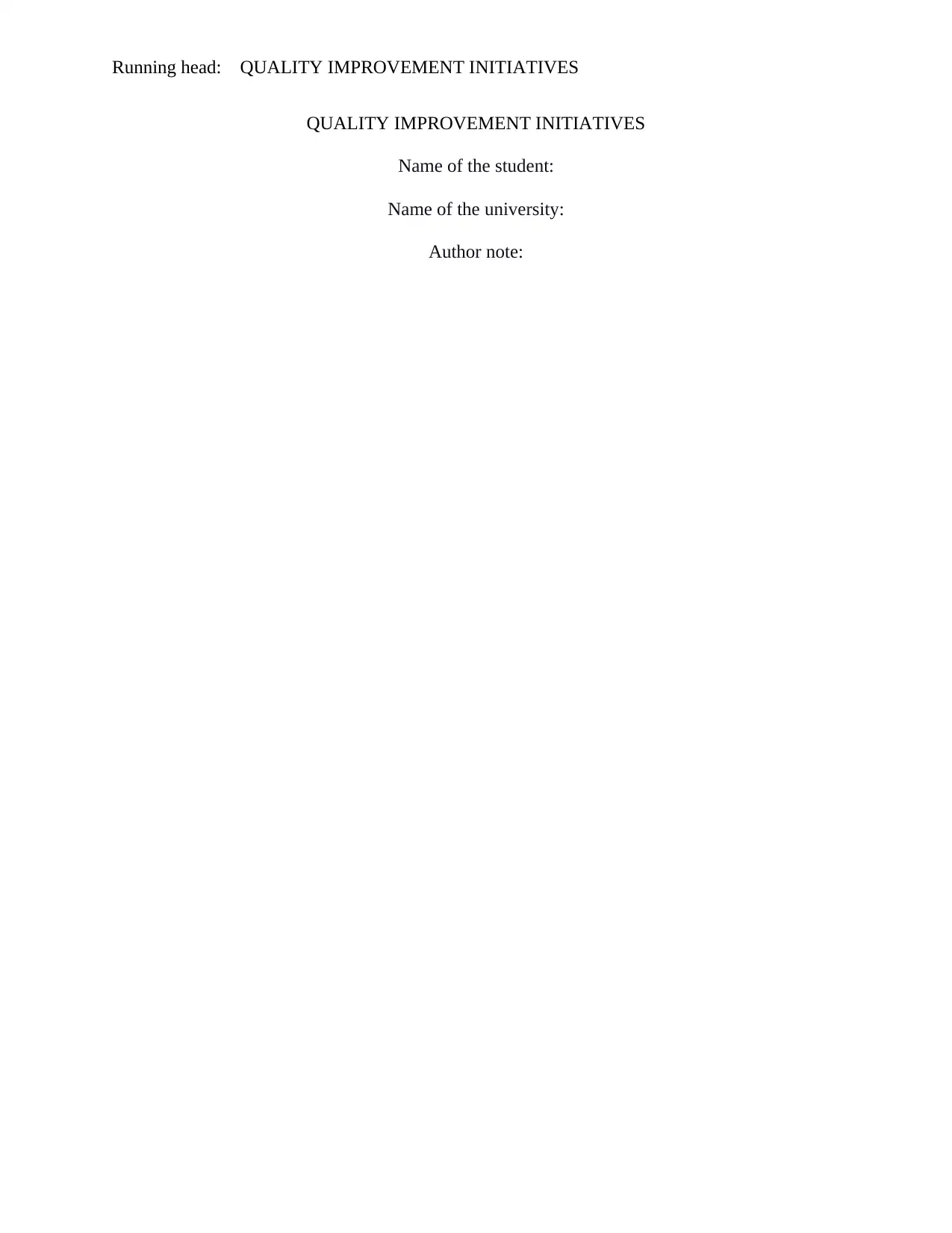
Running head: QUALITY IMPROVEMENT INITIATIVES
QUALITY IMPROVEMENT INITIATIVES
Name of the student:
Name of the university:
Author note:
QUALITY IMPROVEMENT INITIATIVES
Name of the student:
Name of the university:
Author note:
Paraphrase This Document
Need a fresh take? Get an instant paraphrase of this document with our AI Paraphraser
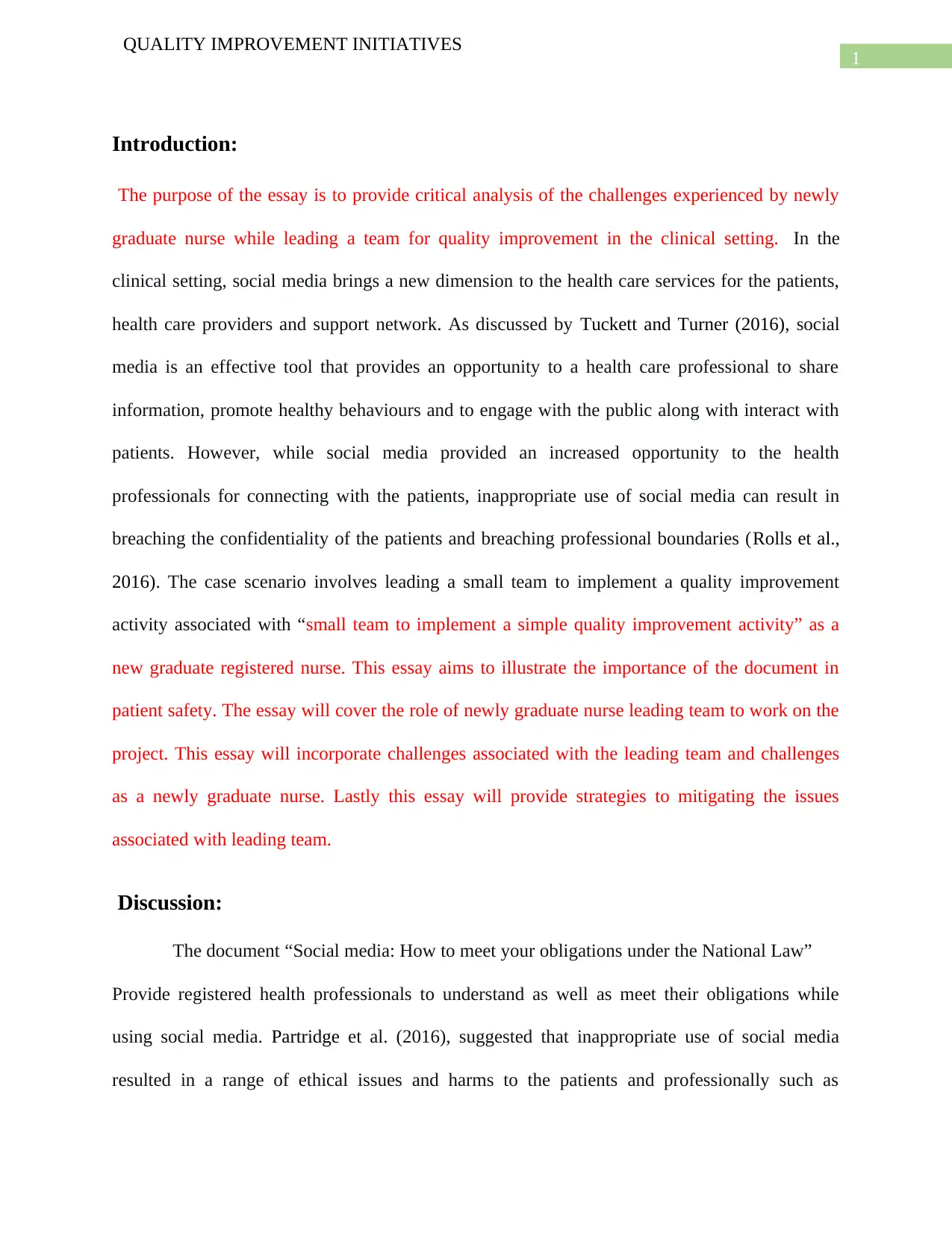
1
QUALITY IMPROVEMENT INITIATIVES
Introduction:
The purpose of the essay is to provide critical analysis of the challenges experienced by newly
graduate nurse while leading a team for quality improvement in the clinical setting. In the
clinical setting, social media brings a new dimension to the health care services for the patients,
health care providers and support network. As discussed by Tuckett and Turner (2016), social
media is an effective tool that provides an opportunity to a health care professional to share
information, promote healthy behaviours and to engage with the public along with interact with
patients. However, while social media provided an increased opportunity to the health
professionals for connecting with the patients, inappropriate use of social media can result in
breaching the confidentiality of the patients and breaching professional boundaries (Rolls et al.,
2016). The case scenario involves leading a small team to implement a quality improvement
activity associated with “small team to implement a simple quality improvement activity” as a
new graduate registered nurse. This essay aims to illustrate the importance of the document in
patient safety. The essay will cover the role of newly graduate nurse leading team to work on the
project. This essay will incorporate challenges associated with the leading team and challenges
as a newly graduate nurse. Lastly this essay will provide strategies to mitigating the issues
associated with leading team.
Discussion:
The document “Social media: How to meet your obligations under the National Law”
Provide registered health professionals to understand as well as meet their obligations while
using social media. Partridge et al. (2016), suggested that inappropriate use of social media
resulted in a range of ethical issues and harms to the patients and professionally such as
QUALITY IMPROVEMENT INITIATIVES
Introduction:
The purpose of the essay is to provide critical analysis of the challenges experienced by newly
graduate nurse while leading a team for quality improvement in the clinical setting. In the
clinical setting, social media brings a new dimension to the health care services for the patients,
health care providers and support network. As discussed by Tuckett and Turner (2016), social
media is an effective tool that provides an opportunity to a health care professional to share
information, promote healthy behaviours and to engage with the public along with interact with
patients. However, while social media provided an increased opportunity to the health
professionals for connecting with the patients, inappropriate use of social media can result in
breaching the confidentiality of the patients and breaching professional boundaries (Rolls et al.,
2016). The case scenario involves leading a small team to implement a quality improvement
activity associated with “small team to implement a simple quality improvement activity” as a
new graduate registered nurse. This essay aims to illustrate the importance of the document in
patient safety. The essay will cover the role of newly graduate nurse leading team to work on the
project. This essay will incorporate challenges associated with the leading team and challenges
as a newly graduate nurse. Lastly this essay will provide strategies to mitigating the issues
associated with leading team.
Discussion:
The document “Social media: How to meet your obligations under the National Law”
Provide registered health professionals to understand as well as meet their obligations while
using social media. Partridge et al. (2016), suggested that inappropriate use of social media
resulted in a range of ethical issues and harms to the patients and professionally such as
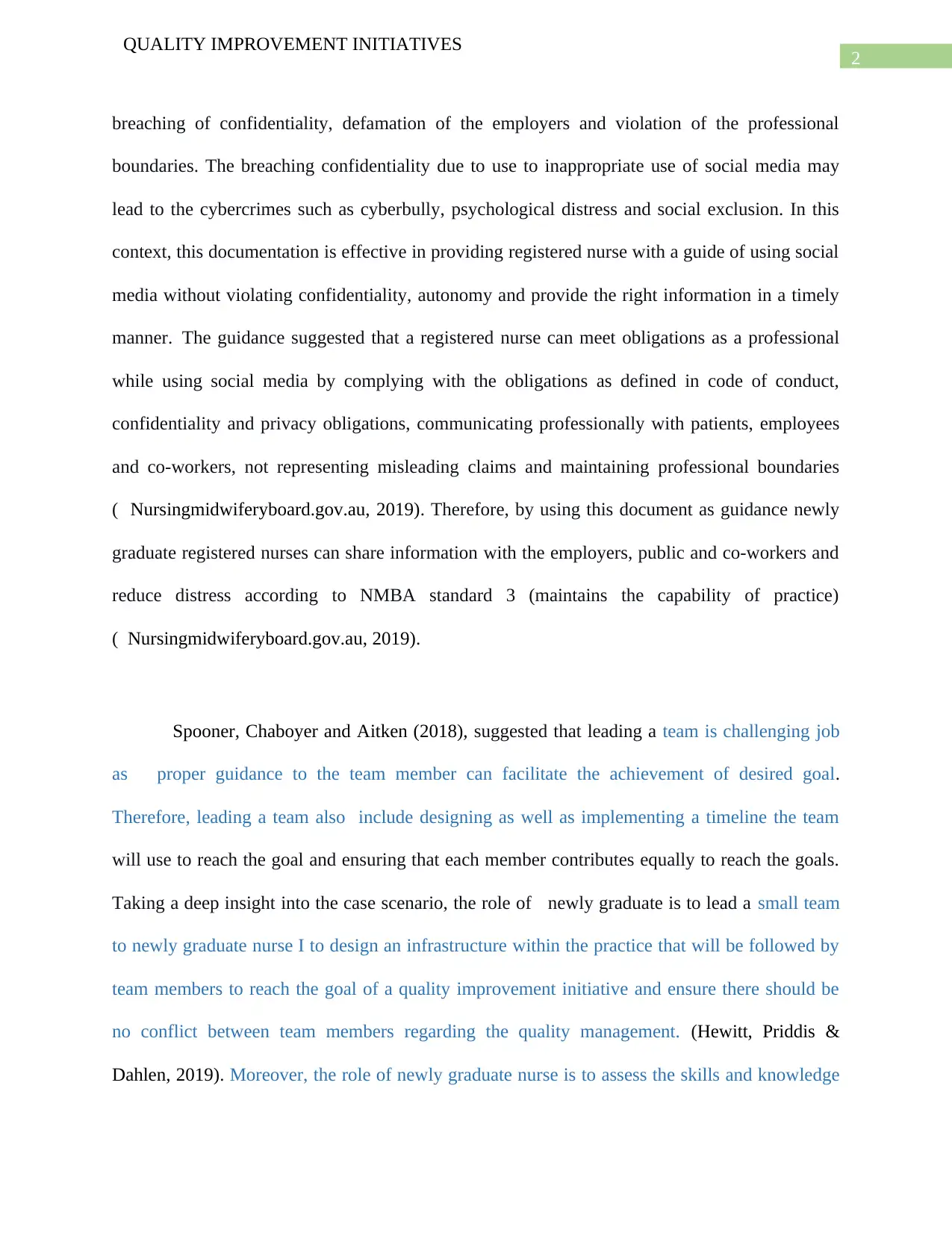
2
QUALITY IMPROVEMENT INITIATIVES
breaching of confidentiality, defamation of the employers and violation of the professional
boundaries. The breaching confidentiality due to use to inappropriate use of social media may
lead to the cybercrimes such as cyberbully, psychological distress and social exclusion. In this
context, this documentation is effective in providing registered nurse with a guide of using social
media without violating confidentiality, autonomy and provide the right information in a timely
manner. The guidance suggested that a registered nurse can meet obligations as a professional
while using social media by complying with the obligations as defined in code of conduct,
confidentiality and privacy obligations, communicating professionally with patients, employees
and co-workers, not representing misleading claims and maintaining professional boundaries
( Nursingmidwiferyboard.gov.au, 2019). Therefore, by using this document as guidance newly
graduate registered nurses can share information with the employers, public and co-workers and
reduce distress according to NMBA standard 3 (maintains the capability of practice)
( Nursingmidwiferyboard.gov.au, 2019).
Spooner, Chaboyer and Aitken (2018), suggested that leading a team is challenging job
as proper guidance to the team member can facilitate the achievement of desired goal.
Therefore, leading a team also include designing as well as implementing a timeline the team
will use to reach the goal and ensuring that each member contributes equally to reach the goals.
Taking a deep insight into the case scenario, the role of newly graduate is to lead a small team
to newly graduate nurse I to design an infrastructure within the practice that will be followed by
team members to reach the goal of a quality improvement initiative and ensure there should be
no conflict between team members regarding the quality management. (Hewitt, Priddis &
Dahlen, 2019). Moreover, the role of newly graduate nurse is to assess the skills and knowledge
QUALITY IMPROVEMENT INITIATIVES
breaching of confidentiality, defamation of the employers and violation of the professional
boundaries. The breaching confidentiality due to use to inappropriate use of social media may
lead to the cybercrimes such as cyberbully, psychological distress and social exclusion. In this
context, this documentation is effective in providing registered nurse with a guide of using social
media without violating confidentiality, autonomy and provide the right information in a timely
manner. The guidance suggested that a registered nurse can meet obligations as a professional
while using social media by complying with the obligations as defined in code of conduct,
confidentiality and privacy obligations, communicating professionally with patients, employees
and co-workers, not representing misleading claims and maintaining professional boundaries
( Nursingmidwiferyboard.gov.au, 2019). Therefore, by using this document as guidance newly
graduate registered nurses can share information with the employers, public and co-workers and
reduce distress according to NMBA standard 3 (maintains the capability of practice)
( Nursingmidwiferyboard.gov.au, 2019).
Spooner, Chaboyer and Aitken (2018), suggested that leading a team is challenging job
as proper guidance to the team member can facilitate the achievement of desired goal.
Therefore, leading a team also include designing as well as implementing a timeline the team
will use to reach the goal and ensuring that each member contributes equally to reach the goals.
Taking a deep insight into the case scenario, the role of newly graduate is to lead a small team
to newly graduate nurse I to design an infrastructure within the practice that will be followed by
team members to reach the goal of a quality improvement initiative and ensure there should be
no conflict between team members regarding the quality management. (Hewitt, Priddis &
Dahlen, 2019). Moreover, the role of newly graduate nurse is to assess the skills and knowledge
⊘ This is a preview!⊘
Do you want full access?
Subscribe today to unlock all pages.

Trusted by 1+ million students worldwide
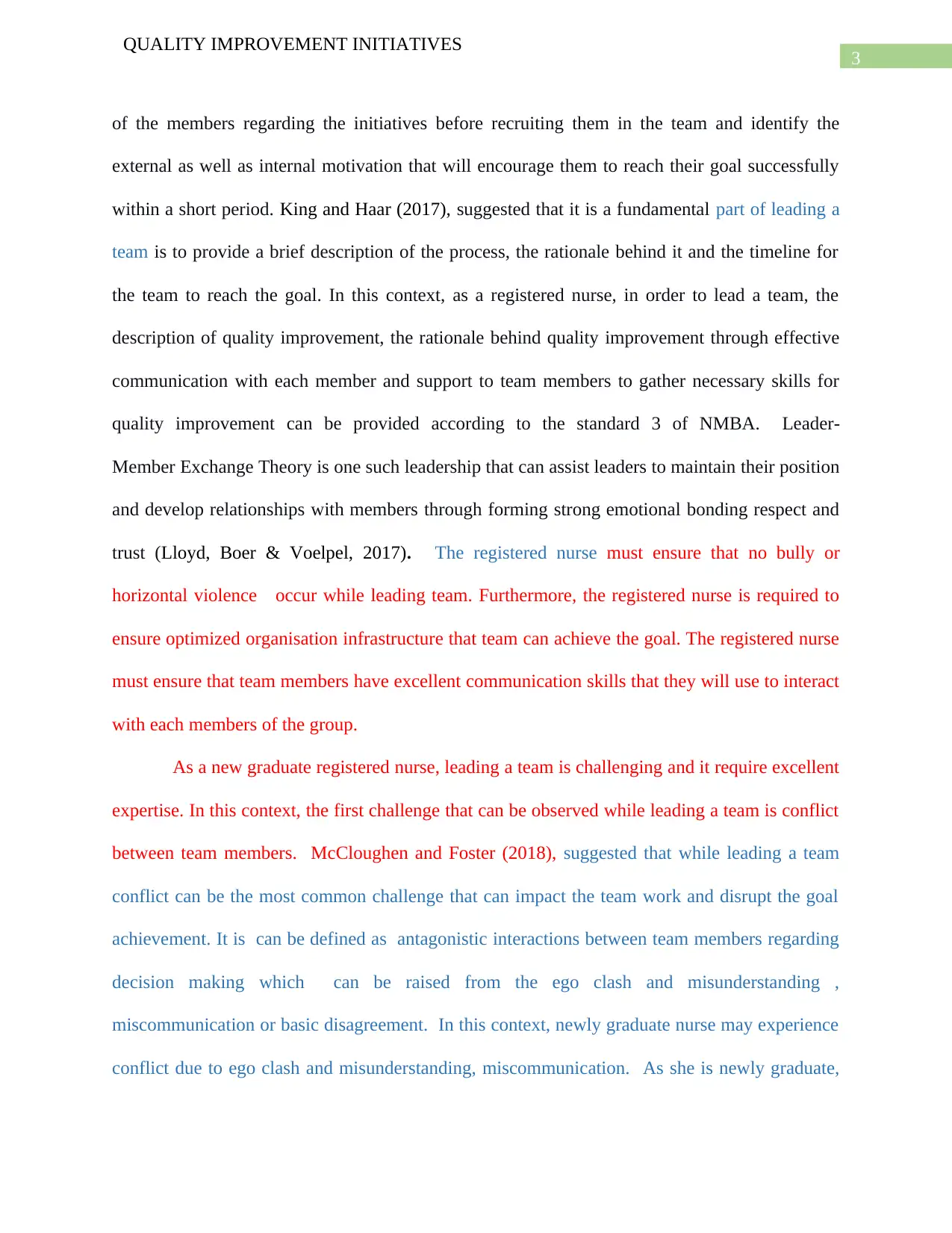
3
QUALITY IMPROVEMENT INITIATIVES
of the members regarding the initiatives before recruiting them in the team and identify the
external as well as internal motivation that will encourage them to reach their goal successfully
within a short period. King and Haar (2017), suggested that it is a fundamental part of leading a
team is to provide a brief description of the process, the rationale behind it and the timeline for
the team to reach the goal. In this context, as a registered nurse, in order to lead a team, the
description of quality improvement, the rationale behind quality improvement through effective
communication with each member and support to team members to gather necessary skills for
quality improvement can be provided according to the standard 3 of NMBA. Leader-
Member Exchange Theory is one such leadership that can assist leaders to maintain their position
and develop relationships with members through forming strong emotional bonding respect and
trust (Lloyd, Boer & Voelpel, 2017). The registered nurse must ensure that no bully or
horizontal violence occur while leading team. Furthermore, the registered nurse is required to
ensure optimized organisation infrastructure that team can achieve the goal. The registered nurse
must ensure that team members have excellent communication skills that they will use to interact
with each members of the group.
As a new graduate registered nurse, leading a team is challenging and it require excellent
expertise. In this context, the first challenge that can be observed while leading a team is conflict
between team members. McCloughen and Foster (2018), suggested that while leading a team
conflict can be the most common challenge that can impact the team work and disrupt the goal
achievement. It is can be defined as antagonistic interactions between team members regarding
decision making which can be raised from the ego clash and misunderstanding ,
miscommunication or basic disagreement. In this context, newly graduate nurse may experience
conflict due to ego clash and misunderstanding, miscommunication. As she is newly graduate,
QUALITY IMPROVEMENT INITIATIVES
of the members regarding the initiatives before recruiting them in the team and identify the
external as well as internal motivation that will encourage them to reach their goal successfully
within a short period. King and Haar (2017), suggested that it is a fundamental part of leading a
team is to provide a brief description of the process, the rationale behind it and the timeline for
the team to reach the goal. In this context, as a registered nurse, in order to lead a team, the
description of quality improvement, the rationale behind quality improvement through effective
communication with each member and support to team members to gather necessary skills for
quality improvement can be provided according to the standard 3 of NMBA. Leader-
Member Exchange Theory is one such leadership that can assist leaders to maintain their position
and develop relationships with members through forming strong emotional bonding respect and
trust (Lloyd, Boer & Voelpel, 2017). The registered nurse must ensure that no bully or
horizontal violence occur while leading team. Furthermore, the registered nurse is required to
ensure optimized organisation infrastructure that team can achieve the goal. The registered nurse
must ensure that team members have excellent communication skills that they will use to interact
with each members of the group.
As a new graduate registered nurse, leading a team is challenging and it require excellent
expertise. In this context, the first challenge that can be observed while leading a team is conflict
between team members. McCloughen and Foster (2018), suggested that while leading a team
conflict can be the most common challenge that can impact the team work and disrupt the goal
achievement. It is can be defined as antagonistic interactions between team members regarding
decision making which can be raised from the ego clash and misunderstanding ,
miscommunication or basic disagreement. In this context, newly graduate nurse may experience
conflict due to ego clash and misunderstanding, miscommunication. As she is newly graduate,
Paraphrase This Document
Need a fresh take? Get an instant paraphrase of this document with our AI Paraphraser
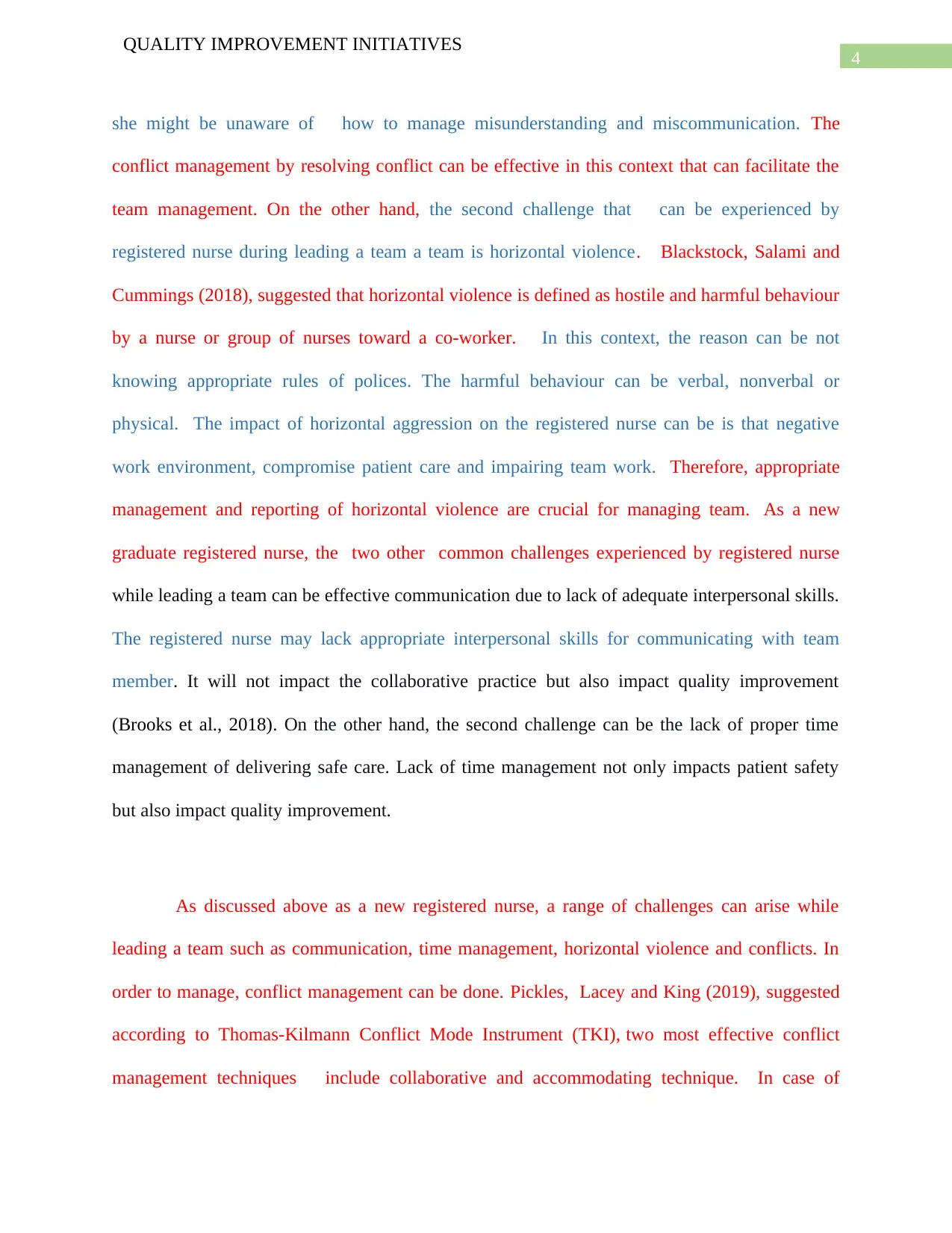
4
QUALITY IMPROVEMENT INITIATIVES
she might be unaware of how to manage misunderstanding and miscommunication. The
conflict management by resolving conflict can be effective in this context that can facilitate the
team management. On the other hand, the second challenge that can be experienced by
registered nurse during leading a team a team is horizontal violence. Blackstock, Salami and
Cummings (2018), suggested that horizontal violence is defined as hostile and harmful behaviour
by a nurse or group of nurses toward a co-worker. In this context, the reason can be not
knowing appropriate rules of polices. The harmful behaviour can be verbal, nonverbal or
physical. The impact of horizontal aggression on the registered nurse can be is that negative
work environment, compromise patient care and impairing team work. Therefore, appropriate
management and reporting of horizontal violence are crucial for managing team. As a new
graduate registered nurse, the two other common challenges experienced by registered nurse
while leading a team can be effective communication due to lack of adequate interpersonal skills.
The registered nurse may lack appropriate interpersonal skills for communicating with team
member. It will not impact the collaborative practice but also impact quality improvement
(Brooks et al., 2018). On the other hand, the second challenge can be the lack of proper time
management of delivering safe care. Lack of time management not only impacts patient safety
but also impact quality improvement.
As discussed above as a new registered nurse, a range of challenges can arise while
leading a team such as communication, time management, horizontal violence and conflicts. In
order to manage, conflict management can be done. Pickles, Lacey and King (2019), suggested
according to Thomas-Kilmann Conflict Mode Instrument (TKI), two most effective conflict
management techniques include collaborative and accommodating technique. In case of
QUALITY IMPROVEMENT INITIATIVES
she might be unaware of how to manage misunderstanding and miscommunication. The
conflict management by resolving conflict can be effective in this context that can facilitate the
team management. On the other hand, the second challenge that can be experienced by
registered nurse during leading a team a team is horizontal violence. Blackstock, Salami and
Cummings (2018), suggested that horizontal violence is defined as hostile and harmful behaviour
by a nurse or group of nurses toward a co-worker. In this context, the reason can be not
knowing appropriate rules of polices. The harmful behaviour can be verbal, nonverbal or
physical. The impact of horizontal aggression on the registered nurse can be is that negative
work environment, compromise patient care and impairing team work. Therefore, appropriate
management and reporting of horizontal violence are crucial for managing team. As a new
graduate registered nurse, the two other common challenges experienced by registered nurse
while leading a team can be effective communication due to lack of adequate interpersonal skills.
The registered nurse may lack appropriate interpersonal skills for communicating with team
member. It will not impact the collaborative practice but also impact quality improvement
(Brooks et al., 2018). On the other hand, the second challenge can be the lack of proper time
management of delivering safe care. Lack of time management not only impacts patient safety
but also impact quality improvement.
As discussed above as a new registered nurse, a range of challenges can arise while
leading a team such as communication, time management, horizontal violence and conflicts. In
order to manage, conflict management can be done. Pickles, Lacey and King (2019), suggested
according to Thomas-Kilmann Conflict Mode Instrument (TKI), two most effective conflict
management techniques include collaborative and accommodating technique. In case of
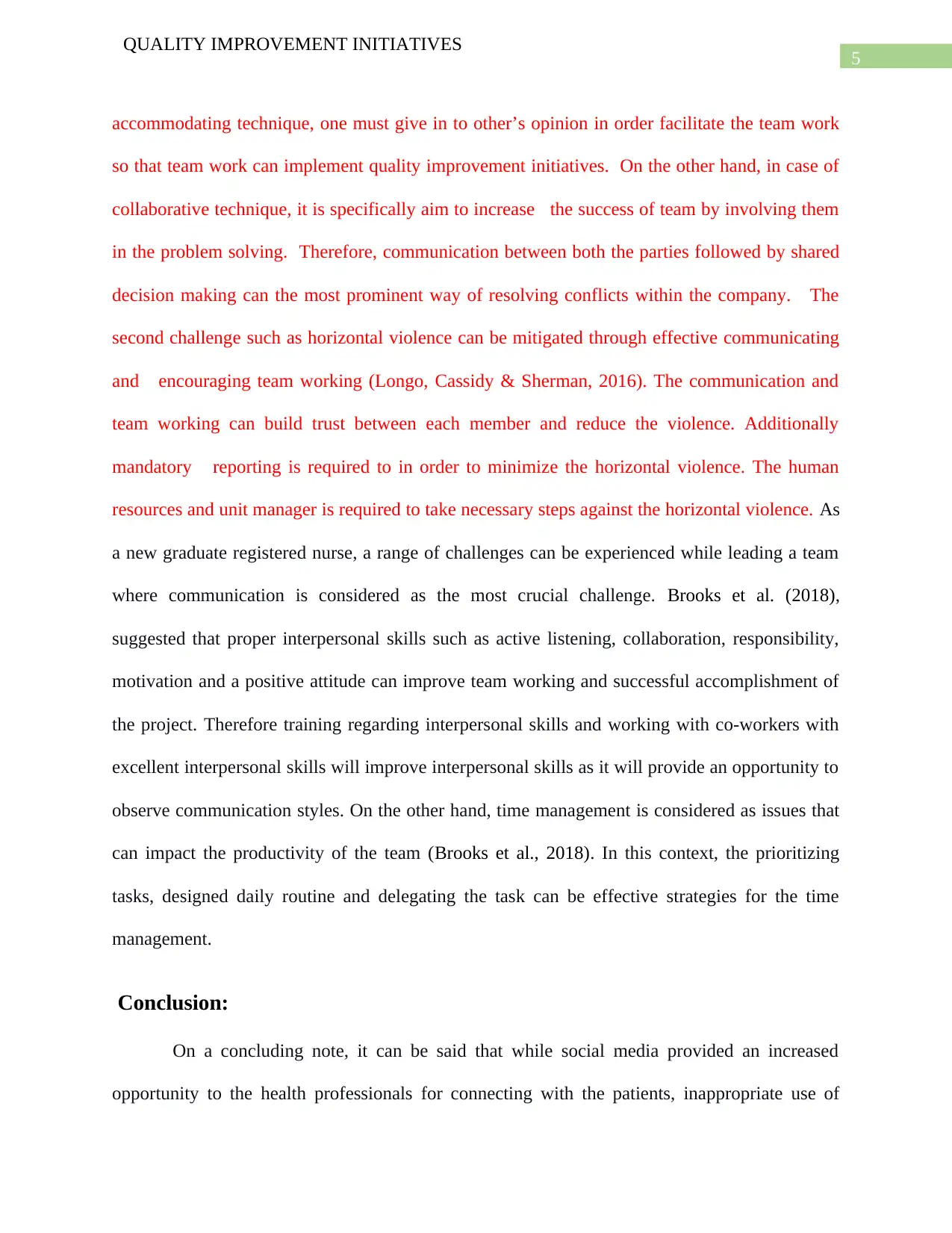
5
QUALITY IMPROVEMENT INITIATIVES
accommodating technique, one must give in to other’s opinion in order facilitate the team work
so that team work can implement quality improvement initiatives. On the other hand, in case of
collaborative technique, it is specifically aim to increase the success of team by involving them
in the problem solving. Therefore, communication between both the parties followed by shared
decision making can the most prominent way of resolving conflicts within the company. The
second challenge such as horizontal violence can be mitigated through effective communicating
and encouraging team working (Longo, Cassidy & Sherman, 2016). The communication and
team working can build trust between each member and reduce the violence. Additionally
mandatory reporting is required to in order to minimize the horizontal violence. The human
resources and unit manager is required to take necessary steps against the horizontal violence. As
a new graduate registered nurse, a range of challenges can be experienced while leading a team
where communication is considered as the most crucial challenge. Brooks et al. (2018),
suggested that proper interpersonal skills such as active listening, collaboration, responsibility,
motivation and a positive attitude can improve team working and successful accomplishment of
the project. Therefore training regarding interpersonal skills and working with co-workers with
excellent interpersonal skills will improve interpersonal skills as it will provide an opportunity to
observe communication styles. On the other hand, time management is considered as issues that
can impact the productivity of the team (Brooks et al., 2018). In this context, the prioritizing
tasks, designed daily routine and delegating the task can be effective strategies for the time
management.
Conclusion:
On a concluding note, it can be said that while social media provided an increased
opportunity to the health professionals for connecting with the patients, inappropriate use of
QUALITY IMPROVEMENT INITIATIVES
accommodating technique, one must give in to other’s opinion in order facilitate the team work
so that team work can implement quality improvement initiatives. On the other hand, in case of
collaborative technique, it is specifically aim to increase the success of team by involving them
in the problem solving. Therefore, communication between both the parties followed by shared
decision making can the most prominent way of resolving conflicts within the company. The
second challenge such as horizontal violence can be mitigated through effective communicating
and encouraging team working (Longo, Cassidy & Sherman, 2016). The communication and
team working can build trust between each member and reduce the violence. Additionally
mandatory reporting is required to in order to minimize the horizontal violence. The human
resources and unit manager is required to take necessary steps against the horizontal violence. As
a new graduate registered nurse, a range of challenges can be experienced while leading a team
where communication is considered as the most crucial challenge. Brooks et al. (2018),
suggested that proper interpersonal skills such as active listening, collaboration, responsibility,
motivation and a positive attitude can improve team working and successful accomplishment of
the project. Therefore training regarding interpersonal skills and working with co-workers with
excellent interpersonal skills will improve interpersonal skills as it will provide an opportunity to
observe communication styles. On the other hand, time management is considered as issues that
can impact the productivity of the team (Brooks et al., 2018). In this context, the prioritizing
tasks, designed daily routine and delegating the task can be effective strategies for the time
management.
Conclusion:
On a concluding note, it can be said that while social media provided an increased
opportunity to the health professionals for connecting with the patients, inappropriate use of
⊘ This is a preview!⊘
Do you want full access?
Subscribe today to unlock all pages.

Trusted by 1+ million students worldwide
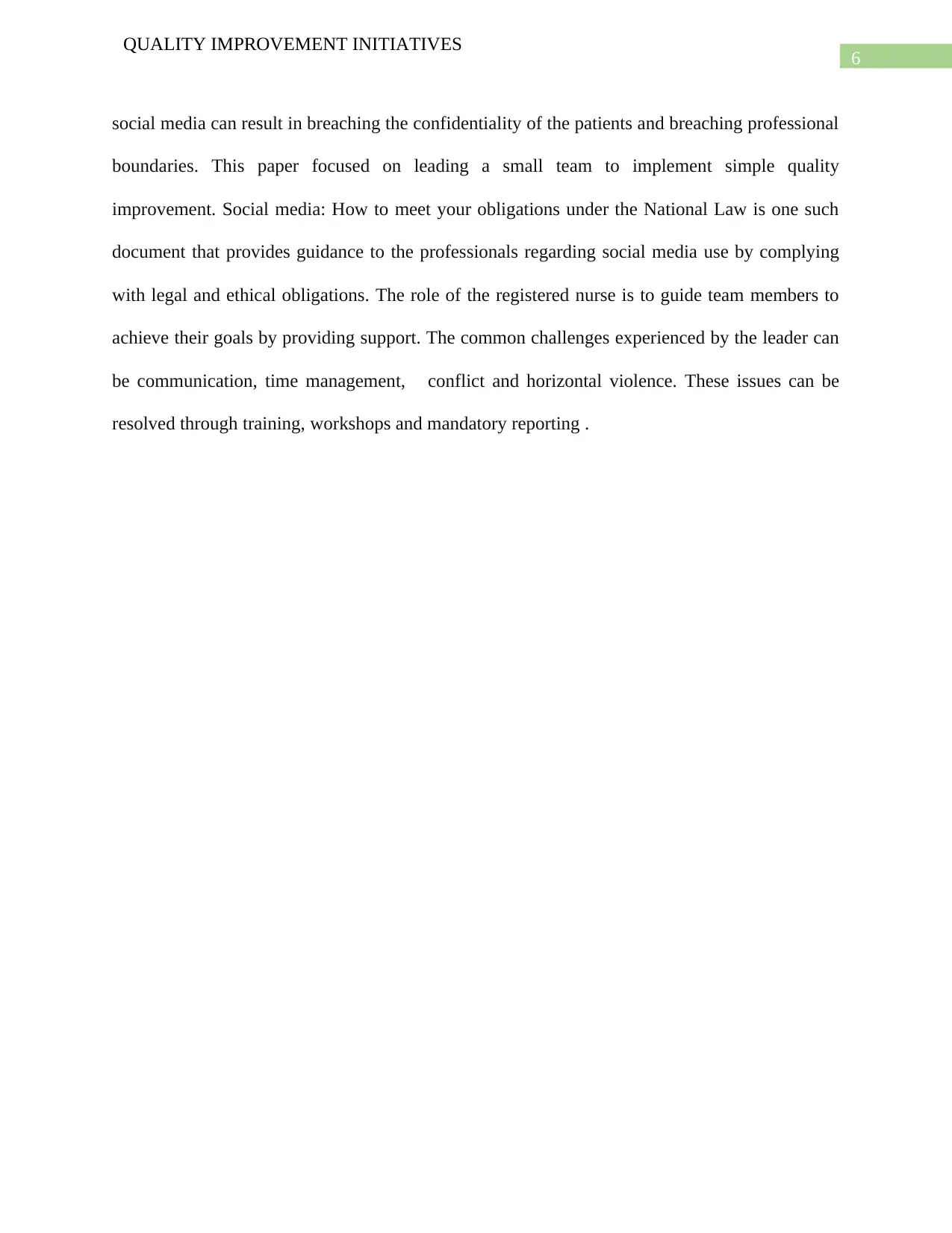
6
QUALITY IMPROVEMENT INITIATIVES
social media can result in breaching the confidentiality of the patients and breaching professional
boundaries. This paper focused on leading a small team to implement simple quality
improvement. Social media: How to meet your obligations under the National Law is one such
document that provides guidance to the professionals regarding social media use by complying
with legal and ethical obligations. The role of the registered nurse is to guide team members to
achieve their goals by providing support. The common challenges experienced by the leader can
be communication, time management, conflict and horizontal violence. These issues can be
resolved through training, workshops and mandatory reporting .
QUALITY IMPROVEMENT INITIATIVES
social media can result in breaching the confidentiality of the patients and breaching professional
boundaries. This paper focused on leading a small team to implement simple quality
improvement. Social media: How to meet your obligations under the National Law is one such
document that provides guidance to the professionals regarding social media use by complying
with legal and ethical obligations. The role of the registered nurse is to guide team members to
achieve their goals by providing support. The common challenges experienced by the leader can
be communication, time management, conflict and horizontal violence. These issues can be
resolved through training, workshops and mandatory reporting .
Paraphrase This Document
Need a fresh take? Get an instant paraphrase of this document with our AI Paraphraser
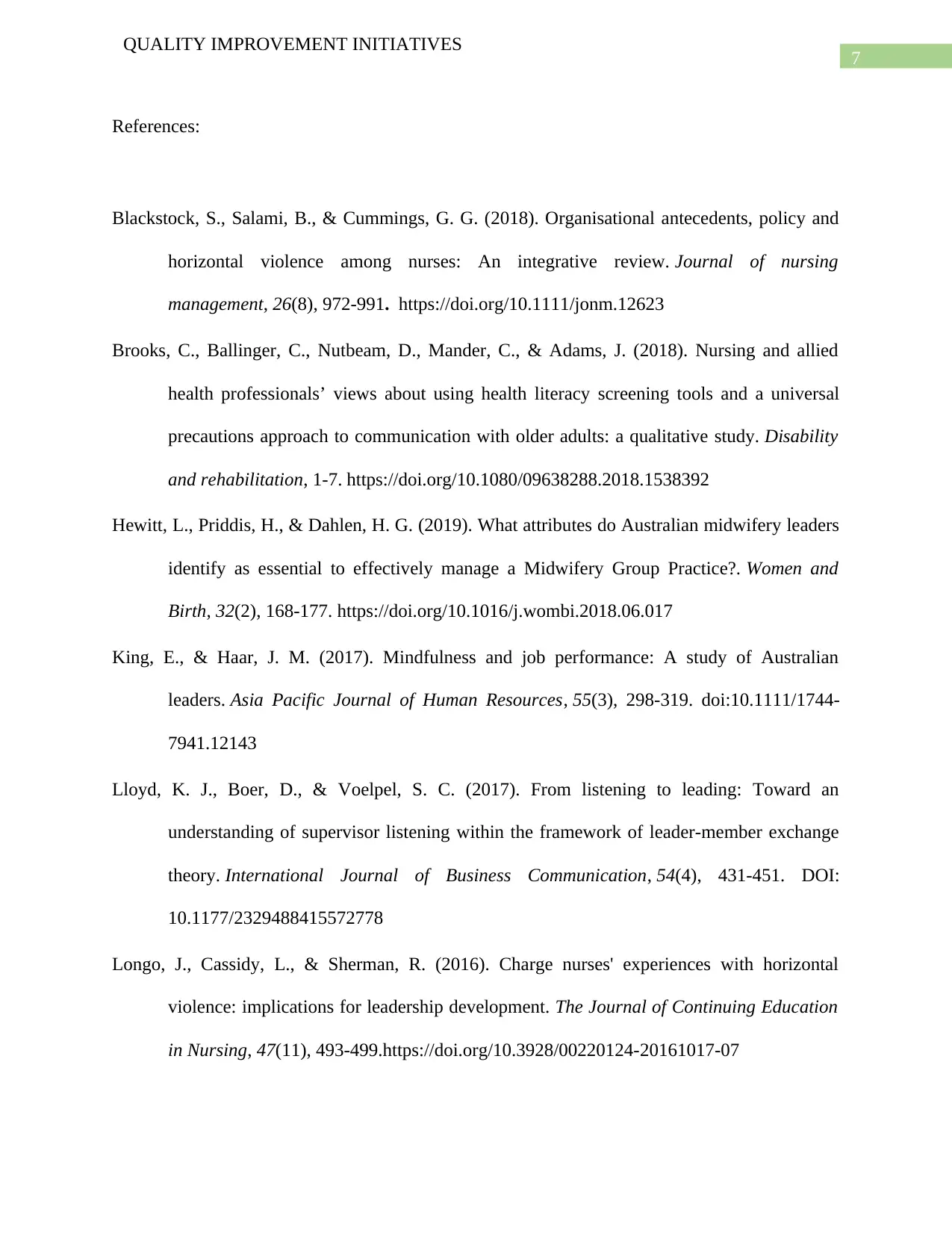
7
QUALITY IMPROVEMENT INITIATIVES
References:
Blackstock, S., Salami, B., & Cummings, G. G. (2018). Organisational antecedents, policy and
horizontal violence among nurses: An integrative review. Journal of nursing
management, 26(8), 972-991. https://doi.org/10.1111/jonm.12623
Brooks, C., Ballinger, C., Nutbeam, D., Mander, C., & Adams, J. (2018). Nursing and allied
health professionals’ views about using health literacy screening tools and a universal
precautions approach to communication with older adults: a qualitative study. Disability
and rehabilitation, 1-7. https://doi.org/10.1080/09638288.2018.1538392
Hewitt, L., Priddis, H., & Dahlen, H. G. (2019). What attributes do Australian midwifery leaders
identify as essential to effectively manage a Midwifery Group Practice?. Women and
Birth, 32(2), 168-177. https://doi.org/10.1016/j.wombi.2018.06.017
King, E., & Haar, J. M. (2017). Mindfulness and job performance: A study of Australian
leaders. Asia Pacific Journal of Human Resources, 55(3), 298-319. doi:10.1111/1744-
7941.12143
Lloyd, K. J., Boer, D., & Voelpel, S. C. (2017). From listening to leading: Toward an
understanding of supervisor listening within the framework of leader-member exchange
theory. International Journal of Business Communication, 54(4), 431-451. DOI:
10.1177/2329488415572778
Longo, J., Cassidy, L., & Sherman, R. (2016). Charge nurses' experiences with horizontal
violence: implications for leadership development. The Journal of Continuing Education
in Nursing, 47(11), 493-499.https://doi.org/10.3928/00220124-20161017-07
QUALITY IMPROVEMENT INITIATIVES
References:
Blackstock, S., Salami, B., & Cummings, G. G. (2018). Organisational antecedents, policy and
horizontal violence among nurses: An integrative review. Journal of nursing
management, 26(8), 972-991. https://doi.org/10.1111/jonm.12623
Brooks, C., Ballinger, C., Nutbeam, D., Mander, C., & Adams, J. (2018). Nursing and allied
health professionals’ views about using health literacy screening tools and a universal
precautions approach to communication with older adults: a qualitative study. Disability
and rehabilitation, 1-7. https://doi.org/10.1080/09638288.2018.1538392
Hewitt, L., Priddis, H., & Dahlen, H. G. (2019). What attributes do Australian midwifery leaders
identify as essential to effectively manage a Midwifery Group Practice?. Women and
Birth, 32(2), 168-177. https://doi.org/10.1016/j.wombi.2018.06.017
King, E., & Haar, J. M. (2017). Mindfulness and job performance: A study of Australian
leaders. Asia Pacific Journal of Human Resources, 55(3), 298-319. doi:10.1111/1744-
7941.12143
Lloyd, K. J., Boer, D., & Voelpel, S. C. (2017). From listening to leading: Toward an
understanding of supervisor listening within the framework of leader-member exchange
theory. International Journal of Business Communication, 54(4), 431-451. DOI:
10.1177/2329488415572778
Longo, J., Cassidy, L., & Sherman, R. (2016). Charge nurses' experiences with horizontal
violence: implications for leadership development. The Journal of Continuing Education
in Nursing, 47(11), 493-499.https://doi.org/10.3928/00220124-20161017-07
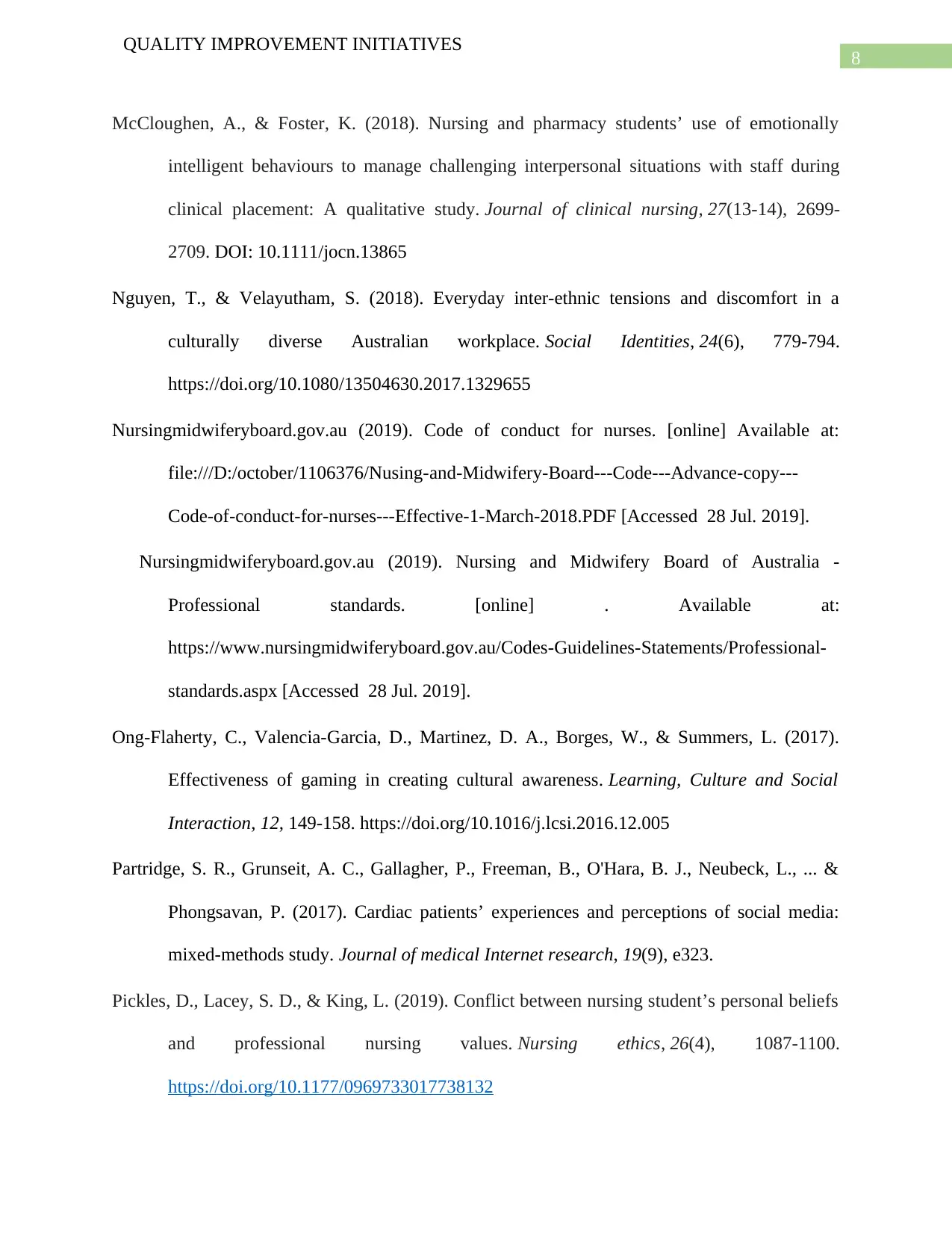
8
QUALITY IMPROVEMENT INITIATIVES
McCloughen, A., & Foster, K. (2018). Nursing and pharmacy students’ use of emotionally
intelligent behaviours to manage challenging interpersonal situations with staff during
clinical placement: A qualitative study. Journal of clinical nursing, 27(13-14), 2699-
2709. DOI: 10.1111/jocn.13865
Nguyen, T., & Velayutham, S. (2018). Everyday inter-ethnic tensions and discomfort in a
culturally diverse Australian workplace. Social Identities, 24(6), 779-794.
https://doi.org/10.1080/13504630.2017.1329655
Nursingmidwiferyboard.gov.au (2019). Code of conduct for nurses. [online] Available at:
file:///D:/october/1106376/Nusing-and-Midwifery-Board---Code---Advance-copy---
Code-of-conduct-for-nurses---Effective-1-March-2018.PDF [Accessed 28 Jul. 2019].
Nursingmidwiferyboard.gov.au (2019). Nursing and Midwifery Board of Australia -
Professional standards. [online] . Available at:
https://www.nursingmidwiferyboard.gov.au/Codes-Guidelines-Statements/Professional-
standards.aspx [Accessed 28 Jul. 2019].
Ong-Flaherty, C., Valencia-Garcia, D., Martinez, D. A., Borges, W., & Summers, L. (2017).
Effectiveness of gaming in creating cultural awareness. Learning, Culture and Social
Interaction, 12, 149-158. https://doi.org/10.1016/j.lcsi.2016.12.005
Partridge, S. R., Grunseit, A. C., Gallagher, P., Freeman, B., O'Hara, B. J., Neubeck, L., ... &
Phongsavan, P. (2017). Cardiac patients’ experiences and perceptions of social media:
mixed-methods study. Journal of medical Internet research, 19(9), e323.
Pickles, D., Lacey, S. D., & King, L. (2019). Conflict between nursing student’s personal beliefs
and professional nursing values. Nursing ethics, 26(4), 1087-1100.
https://doi.org/10.1177/0969733017738132
QUALITY IMPROVEMENT INITIATIVES
McCloughen, A., & Foster, K. (2018). Nursing and pharmacy students’ use of emotionally
intelligent behaviours to manage challenging interpersonal situations with staff during
clinical placement: A qualitative study. Journal of clinical nursing, 27(13-14), 2699-
2709. DOI: 10.1111/jocn.13865
Nguyen, T., & Velayutham, S. (2018). Everyday inter-ethnic tensions and discomfort in a
culturally diverse Australian workplace. Social Identities, 24(6), 779-794.
https://doi.org/10.1080/13504630.2017.1329655
Nursingmidwiferyboard.gov.au (2019). Code of conduct for nurses. [online] Available at:
file:///D:/october/1106376/Nusing-and-Midwifery-Board---Code---Advance-copy---
Code-of-conduct-for-nurses---Effective-1-March-2018.PDF [Accessed 28 Jul. 2019].
Nursingmidwiferyboard.gov.au (2019). Nursing and Midwifery Board of Australia -
Professional standards. [online] . Available at:
https://www.nursingmidwiferyboard.gov.au/Codes-Guidelines-Statements/Professional-
standards.aspx [Accessed 28 Jul. 2019].
Ong-Flaherty, C., Valencia-Garcia, D., Martinez, D. A., Borges, W., & Summers, L. (2017).
Effectiveness of gaming in creating cultural awareness. Learning, Culture and Social
Interaction, 12, 149-158. https://doi.org/10.1016/j.lcsi.2016.12.005
Partridge, S. R., Grunseit, A. C., Gallagher, P., Freeman, B., O'Hara, B. J., Neubeck, L., ... &
Phongsavan, P. (2017). Cardiac patients’ experiences and perceptions of social media:
mixed-methods study. Journal of medical Internet research, 19(9), e323.
Pickles, D., Lacey, S. D., & King, L. (2019). Conflict between nursing student’s personal beliefs
and professional nursing values. Nursing ethics, 26(4), 1087-1100.
https://doi.org/10.1177/0969733017738132
⊘ This is a preview!⊘
Do you want full access?
Subscribe today to unlock all pages.

Trusted by 1+ million students worldwide
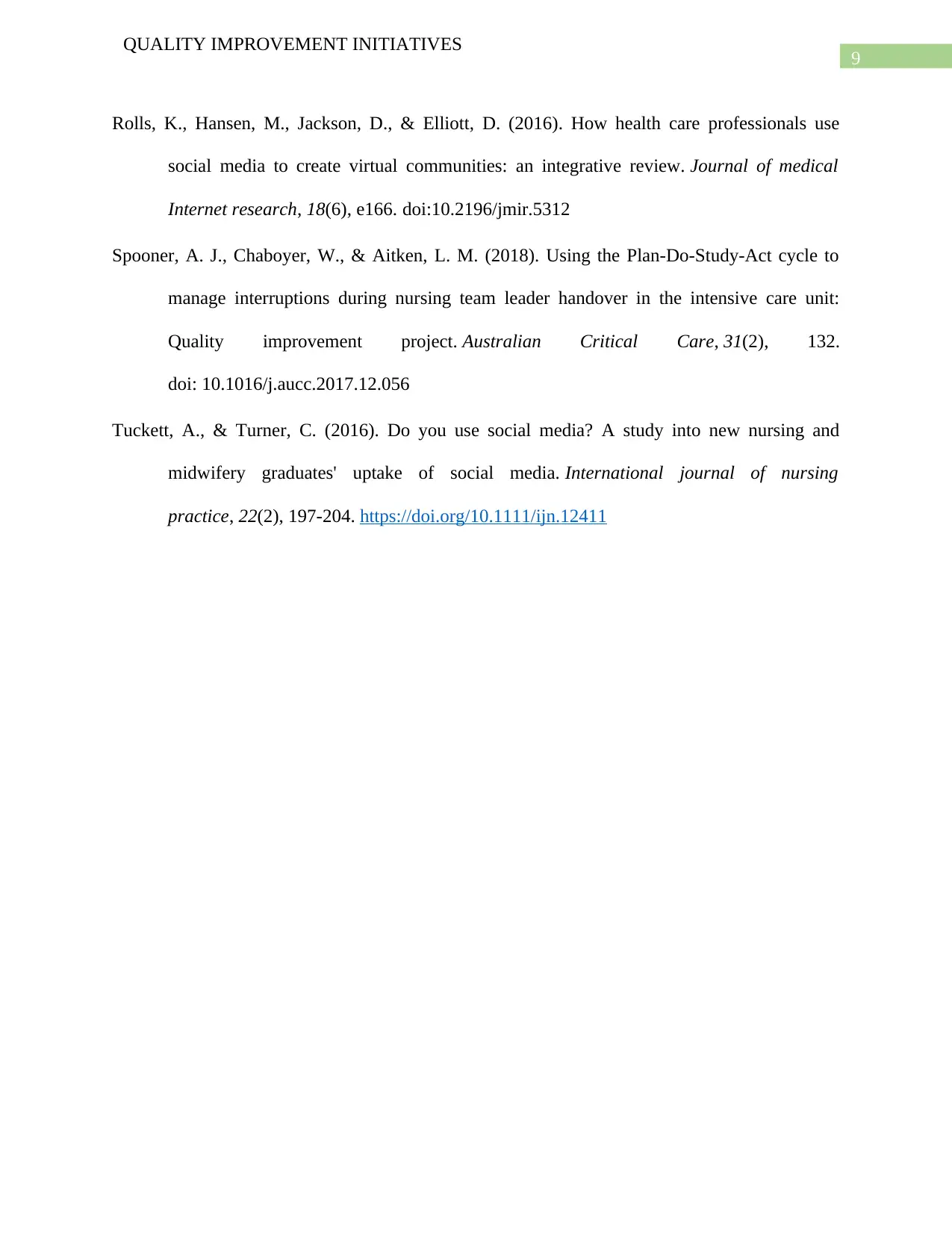
9
QUALITY IMPROVEMENT INITIATIVES
Rolls, K., Hansen, M., Jackson, D., & Elliott, D. (2016). How health care professionals use
social media to create virtual communities: an integrative review. Journal of medical
Internet research, 18(6), e166. doi:10.2196/jmir.5312
Spooner, A. J., Chaboyer, W., & Aitken, L. M. (2018). Using the Plan-Do-Study-Act cycle to
manage interruptions during nursing team leader handover in the intensive care unit:
Quality improvement project. Australian Critical Care, 31(2), 132.
doi: 10.1016/j.aucc.2017.12.056
Tuckett, A., & Turner, C. (2016). Do you use social media? A study into new nursing and
midwifery graduates' uptake of social media. International journal of nursing
practice, 22(2), 197-204. https://doi.org/10.1111/ijn.12411
QUALITY IMPROVEMENT INITIATIVES
Rolls, K., Hansen, M., Jackson, D., & Elliott, D. (2016). How health care professionals use
social media to create virtual communities: an integrative review. Journal of medical
Internet research, 18(6), e166. doi:10.2196/jmir.5312
Spooner, A. J., Chaboyer, W., & Aitken, L. M. (2018). Using the Plan-Do-Study-Act cycle to
manage interruptions during nursing team leader handover in the intensive care unit:
Quality improvement project. Australian Critical Care, 31(2), 132.
doi: 10.1016/j.aucc.2017.12.056
Tuckett, A., & Turner, C. (2016). Do you use social media? A study into new nursing and
midwifery graduates' uptake of social media. International journal of nursing
practice, 22(2), 197-204. https://doi.org/10.1111/ijn.12411
1 out of 10
Related Documents
Your All-in-One AI-Powered Toolkit for Academic Success.
+13062052269
info@desklib.com
Available 24*7 on WhatsApp / Email
![[object Object]](/_next/static/media/star-bottom.7253800d.svg)
Unlock your academic potential
Copyright © 2020–2025 A2Z Services. All Rights Reserved. Developed and managed by ZUCOL.





